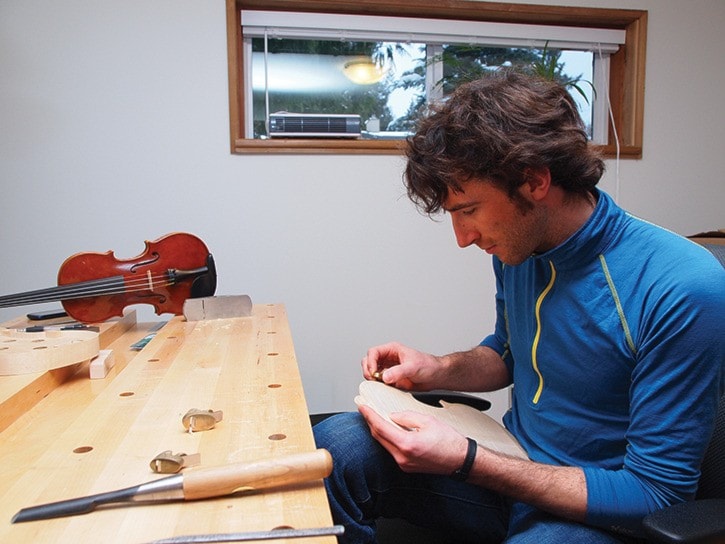To graduate from the Violin Making School of America requires three years of study during which students make seven violins and one cello. To graduate, your work is played and tested. It was during this final test that Robert Quade had one of his biggest thrills.
As he tells it, the principal violinist for the Baltimore Symphony Orchestra was at the school shopping for violins. He came over to the classroom and asked if he could try out Quade’s violin.
“I had a huge grin on my face and said go for it,” Quade told me. “He picked it up and started playing a famous Bach piece. That was a pretty special moment.”
What did he say? I asked.
“He looked at me, he smiled, gave a nice nod, and said, ‘Excellent.’”
Quade had a big grin on his face as he told me the story. The way he spoke of the moment, it felt like he was describing a sensation many would get if Wayne Gretzky showed up to your street hockey game and called you a pretty good player. It’s that excitement and awe you feel when someone at the top of their field compliments you on your work.
Quade, 29, drives trains for CP Rail and spends his time out of work in the mountains. When he’s not partaking in work or play, he makes violins.
He grew up in Calgary the son of a violin bow maker, and Quade said he was jealous of his father’s career and the lifestyle it afforded him.
“He would sit down and make something and take pride in making it, then he’d sell it somebody and whoever bought it would love it,” Quade said.
He looked at following in his father’s footsteps, but was warned of a potential shortage in the wood needed to make violin bows. Instead, he went to Salt Lake City to attend the Violin Making School of America.
A single violin takes anywhere from 6-8 weeks for Quade to make. It requires meticulous attention to detail, near-perfect woodworking, and practically flawless work. Any small defect – be it a tiny crack or knot in the wood, results in a piece getting thrown out.
“I try to work without ever using the phrase good enough,” he said. “It’s always how can this be better or do I finally have this perfect.”
 Robert Quade with one his completed violins.
Robert Quade with one his completed violins.
I met Quade at his apartment, which also doubles as his workshop. He had one finished violin to show me and one that was a work-in-progress.
At school, he got to hold and inspect a $6-million Stradivari violin. “He was very talented with an incredible eye for detail and incredible workmanship.”
Quade’s violins are made with a combination of spruce and maple wood. The first step is carving out a mold that indicates the shape of the violin; the ribs (sidewalls) are cut and bent to the shape of the mold. For the front and back plates, they are first carved as flat pieces and then carefully shaped into a precise arch.
Sound holes are cut into the front plate of the violin – they are shaped to mimic the curvature of the violin’s body.
“They have a very great influence on the sound,” Quade said. “To the eye of a violin maker, they’re all radically differently shaped. To the eye of someone who’s never played a violin before, they all look the same.”
Meanwhile, the scroll – the part the violinist holds onto – is carved into shape. Quade showed me two scrolls he was working on. Unfortunately, they would both have to be thrown out – one because of a knot and one because of a crack.
Once all the pieces are carved, they are glued together and the remaining elements of the violin are attached.
That’s the process a nut shell. In reality, it’s a painstaking process that takes years to master. Quade said everything he makes is accurate to one-tenth of a millimetre. Many pieces have ended up as firewood, he admitted.
“It’s been 10 years and I’m still improving every time,” he said. “I’m still trying to improve every time. If I got worse, then I would quit.”
Quade told me his violins sell for about $4,700, which is actually fairly cheap in the world of handcrafted violin making.
Top makers sell for upwards of $10,000, and the elite in the field for much more. He sells some privately and others through Robertson and Sons Violin Shop in Albuquerque, NM.
“The people that would be buying my instruments would either be talented students or amateur players,” he said. “I’m certainly not selling to professional symphony players just yet.”
Surprisingly, Quade acknowledges he’s not a very adept violinist.
“I can play Twinkle Twinkle and Happy Birthday but not much more complicated than that.”
The model Quade showed me was a Stradivari – from the famous violin maker Antonio Stradivari. “It’s the most common model for makers to follow,” said Quade. “He was a prolific and accomplished maker. He got it right 300 years ago.”
